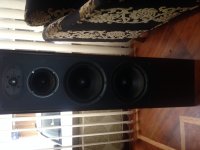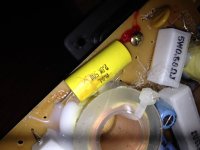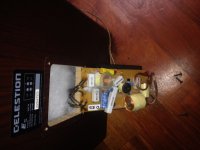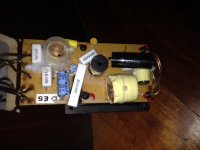Hello everybody.
I have some old Celestion E5 3-way 4 ohms speakers. I'm pretty sure the 3-way crossover has damaged capacitors since mid range speaker doesn't make any sound and tweeter lacks fidelity. They used to have excellent sound which is why I'm trying to replace the crossover capacitors that must be around 15 years old.
I opened the box to look for the components and found a yellow component that says M.D.L 2.0k 50V that does not seem as a resistor and I dont know what it is.
I would appreciate any help. I will post some pictures of the speakers and crossover. Also, do you know any store that ships internationally? I'm from Mexico and it is really hard to find this type of components. If you think theres another reason why sound is not as expected please feel free to tell me.
Thanks a lot, I will appreciate your help.
Sorry if my English is not so good.
Eugenio A



I have some old Celestion E5 3-way 4 ohms speakers. I'm pretty sure the 3-way crossover has damaged capacitors since mid range speaker doesn't make any sound and tweeter lacks fidelity. They used to have excellent sound which is why I'm trying to replace the crossover capacitors that must be around 15 years old.
I opened the box to look for the components and found a yellow component that says M.D.L 2.0k 50V that does not seem as a resistor and I dont know what it is.
I would appreciate any help. I will post some pictures of the speakers and crossover. Also, do you know any store that ships internationally? I'm from Mexico and it is really hard to find this type of components. If you think theres another reason why sound is not as expected please feel free to tell me.
Thanks a lot, I will appreciate your help.
Sorry if my English is not so good.
Eugenio A



Moved to multiway forum 🙂
The yellow part is a capacitor, looks like it could be 2uf non polarised.
If the mid isn't making any sound at all then the first check is to measure across the voice coil on your meter and make sure its not open circuit. The tweeter issue could also be a faulty drive unit. I wouldn't necessarily suspect the crossover components at this stage unfortunately.
The yellow part is a capacitor, looks like it could be 2uf non polarised.
If the mid isn't making any sound at all then the first check is to measure across the voice coil on your meter and make sure its not open circuit. The tweeter issue could also be a faulty drive unit. I wouldn't necessarily suspect the crossover components at this stage unfortunately.
Thank you so much for your reply. I have tried the mid driver wiring it directly (without the crossover and at low volume) and it seems to be working fine. Is there a practical way to know if there's a problem with the crossover without dissembling it? I have a digital multimenter.
Thanks!
Thanks!
Ok, I'll try replacing them. I found the capacitors at partsexpress, shipping to Mexico is 40us. 😱 I hope it is not a waste of money haha. Can I buy polyester caps instead of non polarized? Thanks!
Is that a Bi-wirable speaker and missing the bridge between posts?? If so try a copper wire between posts first
Judging from the shape and dimension the yellow component is a film cap, 2uF with 10% tolerance (the K).
It is unlikely that such a cap fails without any external sign, so before replacing any component I would test every driver separately without the crossover connected.
Ralf
It is unlikely that such a cap fails without any external sign, so before replacing any component I would test every driver separately without the crossover connected.
Ralf
Thank you so much for your reply. I have tried the mid driver wiring it directly (without the crossover and at low volume) and it seems to be working fine. Is there a practical way to know if there's a problem with the crossover without dissembling it? I have a digital multimenter.
Thanks!
I'm assuming you have a pair of these speakers. Are both showing the same problem ? Could you swap the crossovers over to prove them if one speaker was still OK. As the driver seems to be working (from your test) I would be looking for something more obviously "open circuit" such as print/wiring or resistors. Caps like that would be way down the list of suspects.
Judging from the shape and dimension the yellow component is a film cap, 2uF with 10% tolerance (the K).
It is unlikely that such a cap fails without any external sign, so before replacing any component I would test every driver separately without the crossover connected.
Ralf
I agree.
Is that a Bi-wirable speaker and missing the bridge between posts?? If so try a copper wire between posts first
Good catch
If you are sure that your mid and HF drivers are OK, (no short or open circuit, no mechanical noise, rubbing etc.) then you should check those little yellow disc-like parts on the X-over board. Those are self-resetting thermal fuses often used by British manufacturers in the 70's and 80's, for mid and tweeter protection. In normal case they should read a few tenth of Ohm resistance, but sometimes when they open up under overload, just don't reset themselves, and remain in the 10-50 ohm region (found quite a few of them like that). The easiest way to "fix" them, is just bypass it with a piece of wire. Anyway they don't matter much, usually your tweeter blows before they start to protect them...... And don't forget to check the power resistors (the white ceramic parts) they can blow without any visible mark on them.
Last edited:
Thanks everyone for the help!
Being this speakers bi wirable as you said I decided to check if there was any sound coming from the high frequency channel. I had sound from the tweeter but nothing from the "mid" speaker.
Then I decided to check every driver separately as you said and found out that everything worked fine if wired directly to the amp. Good thing there was no problem with the speakers 🙂
I decided to check the only thing that was left, the crossover. I´m a retired mechatronics engineer that still have some little knowledge in circuits so I tracked the speaker wire until I found the place where the signal was completely lost. It was the 7uF cap.
I ordered two of them (6.8uF and 250v instead of 7uF 50V) as they where the only caps I could find so decided to ordered them from partsexpress, had to pay 45usd for shipping but didn´t have many options left haha. Surprisingly I got the caps 36 hours after ordering from the us to Mexico!
I changed the cap in one speaker and is working excellent now! Tomorrow I will do the same for the right speaker, I hope it is the same problem. It is really a huge difference in sound. Now, when I wire to the high frequency channel only I get great mids and highs.
As you can see I didn´t expect the cap to be this big! haha
This is a picture of how the crossover looks now, not really the nicest but does the job 😀. The big black cap is the new one, the old one was a tiny cap haha.

Thanks everyone for the help, I hope this helps someone with the same problem.
Being this speakers bi wirable as you said I decided to check if there was any sound coming from the high frequency channel. I had sound from the tweeter but nothing from the "mid" speaker.
Then I decided to check every driver separately as you said and found out that everything worked fine if wired directly to the amp. Good thing there was no problem with the speakers 🙂
I decided to check the only thing that was left, the crossover. I´m a retired mechatronics engineer that still have some little knowledge in circuits so I tracked the speaker wire until I found the place where the signal was completely lost. It was the 7uF cap.
I ordered two of them (6.8uF and 250v instead of 7uF 50V) as they where the only caps I could find so decided to ordered them from partsexpress, had to pay 45usd for shipping but didn´t have many options left haha. Surprisingly I got the caps 36 hours after ordering from the us to Mexico!
I changed the cap in one speaker and is working excellent now! Tomorrow I will do the same for the right speaker, I hope it is the same problem. It is really a huge difference in sound. Now, when I wire to the high frequency channel only I get great mids and highs.
As you can see I didn´t expect the cap to be this big! haha
This is a picture of how the crossover looks now, not really the nicest but does the job 😀. The big black cap is the new one, the old one was a tiny cap haha.

Thanks everyone for the help, I hope this helps someone with the same problem.
As you can see I didn´t expect the cap to be this big! haha
50V versus 250V? It should be 5 times as big! Yeah, 50V is too low for a crossover. Luckily the capacitor was disconnected. Imagine what happen if the capacitance become half of the original 😀
Great to hear you have it working. I must admit I'm really surprised the caps were faulty... just goes to show 🙂 Well done.
I must admit I'm really surprised the caps were faulty...
Imagine when you build a speaker crossover, a capacitor that should measure 6.8uF only has 6.2uF on the left speaker and 7.0uF on the right. A big mess! That's why LCR meter is a must.
Even in old amps this happens (e.g. in feedback loop).
Imagine when you build a speaker crossover, a capacitor that should measure 6.8uF only has 6.2uF on the left speaker and 7.0uF on the right. A big mess! That's why LCR meter is a must.
Even in old amps this happens (e.g. in feedback loop).
... DMM and a calibration mic
Standard tools of the trade. You wouldn't rebuild an engine without a torque wrench or micrometer now would you? 😉
Take a look on crossover board - there is one item marked as PD1.I'm pretty sure the 3-way crossover has damaged capacitors since mid range speaker doesn't make any sound and tweeter lacks fidelity. They used to have excellent sound which is why I'm trying to replace the crossover capacitors that must be around 15 years old.
It is a kind of "fuse", so, advice you to check this one before you replace working capacitors.
- Status
- Not open for further replies.
- Home
- Loudspeakers
- Multi-Way
- crossover component, what is it?